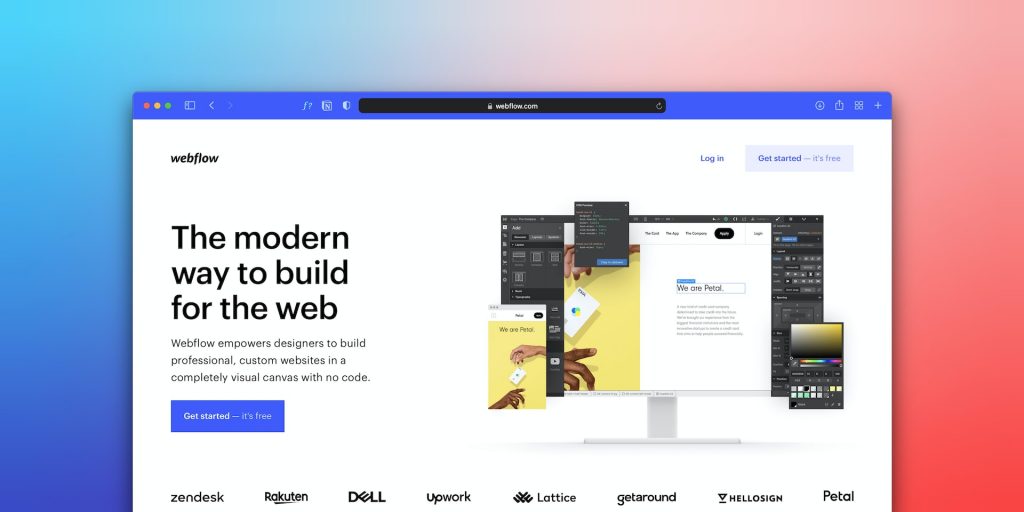
Pros And Cons Of Low Code & No Code App Development
Julian Wallis
18 min read

Business technology has been changing rapidly, and so is the way developers code.
Traditional coding practices have become time-consuming and cumbersome in today’s fast-paced technological world. Because of this, many businesses have been relying on minimal coding to no coding.
Since companies have to adapt themselves to the rapidly changing world of coding, low-code to no-code platforms have flourished. These platforms help businesses to simplify and automate their workflow.
In this blog article, we shall see why it’s essential for companies to embrace digital transformation and how low-code and no-code coding methodologies might be something you should consider in the recent future.
What Is Low Code? 📉
Low code is a software development methodology that helps developers create a software application with little coding. In other words, it is a visual approach to software development, which enables developers to create applications through minimal hand-coding.
A low-code approach uses visually-driven integrated development environments (IDEs) for faster development cycles. Developers with minimal coding experience can then create applications using code blocks and reusable plugin modules.
Sometimes developers might as well skip some steps from the software development life cycle to achieve a rapid development process, thanks to the low-code approach. This approach also relieves the IT team’s backlogs and makes the business process management smoother.
⚙️ How Low Code Works
Low code provides users with a graphical interface for designing software applications. Developers do not need to supplement the design and architecture with good old-fashioned code, as the platform can produce an entire working solution with no additional code required.
In other words, low code eliminates the need to depend on a traditional coding approach, thereby democratising the application development process, particularly for “citizen” developers, i.e., business users (such as project managers or business analysts) with little formal coding experience.

By mapping user interfaces, databases, APIs, and client application behaviours, a low-code approach can produce specifications that users can later use to assemble a working system. These processes may vary from one low-code platform to another, as the business needs and requirements also vary from company to company.
🗃️ Low Code Platforms
There are countless low-code development platforms available in the market. Each differs from the others in many ways, but generally, the guiding principles remain the same. Platforms like Zoho Creator and Salesforce Lightning are web-based and are designed for medium to large businesses. By using scalable APIs, native support, DevOps automation, and quick deployment services of these platforms, you can create applications that your business needs.
In no particular order, here’s a list of low-code platforms you might want to explore further.
Pros Of Low Code 🏆
In today’s age, companies must automate their business processes and prioritise digital transformation. Low code helps them address this by streamlining workflows and accelerating automation.
Here are five reasons why developers are attracted to the low-code development process these days.
⏩ Increased Agility
As businesses are constantly evolving and need to keep up with the pace, they must adopt new and emerging technologies and trends to stay ahead of the competition. That’s why a traditional approach to application development might be time-consuming and complex. Low-code platforms solve this problem by speeding up the application development time and helping companies realise their full potential.
When using a low-code technique, the application development time gets reduced by 50-90%, which reduces deployment and release cycles. Software applications can also be altered and updated as needed because of the shorter release cycles.
👔 Enhanced Productivity
By leveraging the pre-built elements, developers can save a great deal of time when using low-code platforms. Since one is expected to write a minimal amount of code, even business teams can use the platform, significantly reducing the overall time spent on software development. Businesses can then focus on other pressing tasks and projects.
Thanks to the drag-and-drop functionality, anyone with basic programming knowledge can use these platforms to create applications. Complex applications, however, might require more thought and a modular approach. Since most of the low-code platforms follow pre-built templates, you can get a headstart on your project. In turn, this increases the overall efficiency and productivity of the team.
🤑 Cost Savings
Say your company wants to start a new software development project. In that case, you don’t have to wait for a group of expert developers to envision and complete the project. With a team of “citizen users” who know a few things about programming, you can start working on the project right away. This saves time and money.
Low-code platforms are constantly evolving, so there’s no point in being stuck in old and traditional methodologies of writing code. These new platforms are meant to fill the gaps between technology and human resources. What’s more, your existing employees can start leveraging the benefits of low code and build cross-platform applications based on industry standards.
🚀 Ease of Deployment
A traditional software development process consists of many stages. For instance, the waterfall model has five stages: requirements analysis, design, implementation, verification/testing, and deployment/maintenance. Developers must follow these steps, and they often move back and forth between stages to modify the project as per changing business requirements. With a low-code development approach, things can speed up!
With low code, you can revert and modify changes to a stable version with a single click. This clears any application issues, such as bugs and mishaps, one might face during the development cycle. Moreover, developers can sometimes skip one or two steps and directly focus on what is most important, making deployment straightforward.
💻 Greater User Experience
With low code, companies can launch new products that meet customers’ expectations in the market faster. They can also adapt and change their existing products based on the feedback they receive from customers. Besides, low-code automation comes with built-in styles, templates with layouts, widgets, and UI features. By acting as building blocks, they provide intuitive user interfaces and experiences.
The focus with a low-code approach is also on cross-platform and single-click deployment. The best thing is it also supports CI/CD and DevOps — and can integrate easily with external tools to support DevOps, project management, and software testing.
Cons Of Low Code 🙅
Though low code seems to be the best approach in today’s world, there are a few downsides to it that developers should be aware of.

🔓 Security Issues
It’s evident that low-code platforms have built-in security protocols, yet they are not quite good as standalone custom development tools or custom built software solutions. In fact, the security of a low-code software application depends on its automation platform providers. If any issue arises, the automation provider is supposed to fix the problem.
The worst-case scenario is that if these low-code platforms are discontinued, there will not be any security measures for the application. Businesses will then have to spend extra money and resources to fix those issues, and low code might not essentially be a cost-saving solution. If you are still using liquidated or obsolete low-code platforms as hosts, your application will be at a greater security risk, leading to exposure to sensitive data and security vulnerabilities.
⛔ Vendor Lock-In
Another disadvantage of using low code is vendor lock-in. Say you choose one low-code automation platform as a vendor, and in a few years, that platform stops getting updates. In that case, you may as well have to depend entirely on the vendor you have chosen. If you are lucky enough to reuse a clean and standardised code from one vendor to another, the issue can be solved after spending some time and money. Otherwise, you will have to keep using the outdated system.
That’s why it’s imperative to review the vendor’s policy before purchasing the platform’s full licence. Make sure to look at the generated code to know if you can move the code from one system to another easily. Some vendors won’t even allow you to make further changes to your code once they offboard you. Always review the policies and procedures meticulously before deciding on anything.
📊 Tries To Simplify Business Logic
Low code might not be the best solution if you are thinking of developing a complex software application with many different features. Once the initial design and prototyping phases are done, things do get complicated in the world of software development. In such a case, a simple drag-and-drop tool will not solve the problem.
The low code approach tends to simplify business logic, while in the real world, business logic is more often than not a complex thing. For such cases, you will need to find a trusted and reputed software development agency/team that can help you solve the issue by building a state-of-the-art and modern application from scratch.
😕 Limited Customisation & Flexibility
Another disadvantage of low code is how limited the customisation options are. If you want to build native-like applications with custom functionality, you will face many challenges with the low-code approach. Since low code offers a limited number of functions, you won’t have much room to customise your software application.
For instance, if you need a function that’s not in the low code, you will have to take help from a team of developers or a software development agency to write custom code. Then they will integrate this custom code with the preexisting template. Sometimes this might not be the best solution, both economically and technically. Certain low-code vendors don’t even provide such options, meaning customisation is a big challenge with low code.
Low Code App Examples ✨
📱 Erie Insurance’s Mobile App
Erie Insurance, a Fortune 500 insurance company, built its first native mobile app without mobile application developers. Though they had a mobile-responsive computer portal, they needed a native iOS and Android application to serve their customers better. They used Mendix to build their first customer-facing application without hiring a team of developers. What’s more wonderful is this app consists of biometric login, ID verification, and secure transaction — all the cool features of a custom-developed app. Needless to say, the app has dramatically improved its customer experience.
♻️ SoilFarmer – Food2Soil
Food2Soil is a San Diego-based compost reduction network that’s built on Glide. The company strives to make composting accessible and affordable to all San Diegans as they offer three major services: scrap pickup, neighbourhood drop-off, and onsite composting. The app they have built, SoilFarmer, helps its team of technicians to keep organised as the company is constantly expanding and evolving.
⏰ Equina Scheduling
Equina Scheduling is an application that is specifically designed for the healthcare industry. The app connects healthcare employees and ensures shift changes are communicated effectively to them. This app allows you to submit and send shifts with an easy-to-use interface. It also allows schedulers to automate shift change approval based on preset conditions.
So What Is No Code? 0️⃣
As the name suggests, no code is an approach to building apps from scratch without any coding. This takes traditional programming away from the developers.
While the low-code approach is broad in scope and serves both professional and “citizen” developers, it still requires some basic idea/skill about coding. Experts believe that low code serves full-time and part-time developers who are new to the world of coding, while no code is especially meant for business users.
⚙️ How No-Code Works
Like low code, users use the drag-and-drop functionality to create enterprise applications. That means no code is an extension of code that simply makes computer manipulation easier for most users rather than just well-trained programmers.

By using visual interfaces to play around with the code, anyone can design websites or software applications. Besides, there’s a plethora of pre-built templates that one can leverage to get the best out of low-code platforms. While this all sounds like sunflowers and roses, there are a few things you should be aware of. We’ll discuss them in more detail in a moment.
🗃️ No Code Platforms
A wide variety of no-code tools and platforms exist, covering everything from business intelligence to project management. No-code platforms include mobile application builders, website builders, document and form creators, software for email marketing and eCommerce platforms, among many others.
In no particular order, some of the commonly used no-code platforms are listed below.
Low Code Vs No Code — What’s The Difference? 🤷
Simply put, the low-code approach is meant for businesses with limited programming experience. On the other hand, no code is for companies with no programming experience.
Low-code development platforms use visual, declarative techniques instead of traditional programming. However, they require coding skills to complete integration with other systems. No-code uses drag-and-drop tools that appeal to a broader audience without programming knowledge. This is achieved through workflow templates and element libraries.
In other words, applications are built in low code by using built-in features, reusable code templates, plugin modules, and other graphical connectors. But in a no-code environment, all the code is generated by drag-and-drop and point-and-click interfaces. While low code is for beginners with some programming knowledge, no code is for non-technical or business users who might know much about programming.
Pros Of No Code 🏆
Since its emergence, no-code development has appealed to the business and startup community thanks to its many advantages. Here are five notable pros of using a no-code approach.

⏱️ Reduced Development Time
Since building applications with a low-code approach essentially means using the drag-and-drop functionality or point-and-click interfaces, it greatly reduces the overall application development time. Instead of manually typing the code, business users can quickly develop a functional application for release. No code also automates the application testing process, which also helps in reducing development time.
💰 Reduced Costs
Software development is costly and time-consuming, even when building a minimum-viable project for beta users. With no-code platforms, everyday users can reduce up to 80% of the development cost. In the early stages of development — especially for startups — companies can create a workable and functional software application without hiring a team of skilled developers or relying on a software development agency.
🐱💻 Easy Support System
When making small changes to manual coding, developers may also have to spend a considerable amount of time fixing other issues. With no code, making changes is relatively easy. You don’t have to go laboriously through hundreds of thousands of lines of code to find the error; you can simply make the change by using the visual interface. If you want to make a change only have to implement a new logic, and your adjustment will be available in a few hours. Everything seems to be a click away with no-code application development platforms.
🤝 Enhanced Collaboration
With the no-code approach, anyone can do the “coding.” That means, if needed, a business user or a non-technical person can jump in to meet the demand for faster application development and delivery. This approach enables a broader workforce and better collaboration among technical and non-technical teams. Business users also feel involved in the delivery of code, and there’s a sense of ownership.
🐱🏍 User Friendliness
Since no code is easy to use (and it is especially targeted to non-developers), many seem to be attracted towards it. Another reason for this is the user-friendliness of its UI. The aesthetics of no-code platforms invite people from different walks of life to build applications without having to do any form of manual coding. All they have to do is use a drag-and-drop interface that comes with pre-built modules, which makes the development and delivery of an application much easier and faster.
Cons of No Code 🙅♂️
For all the speed, agility, and economic benefits of no code, there are some disadvantages to using no code.
⏸️ Platform-Based Limitations
Though the drag-and-drop tools are of great help to beginners, they also come with some inherent disadvantages. You will be limited to a certain number of fixed options. That means a severe restriction in customising your application as per the needs and requirements. You might as well have to redesign the application, hire a team of developers, and do some additional work to make the changes you want to see in the application. This means price, service quality, and security will be beyond your control.
❌ Unsupported Features
No-code platforms sometimes may not support some low-level features. For example, video/audio processing and device sensors might be challenging. If your application needs such features, you may have to incorporate custom coding with the no-code platform — or perhaps altogether abandon the no-code approach and stick to the traditional path.
No Code App Examples ✨
Despite being a relatively new technology, many users are attracted to no code and have created several applications. Here are four no-code apps built with no-code platforms.
🍱 SmartDish
SmartDish is a Japanese app for ordering food at restaurants. Customers can reserve a table and order meals, which will be delivered immediately after arriving at the restaurant. Created by Royo Moro on Adalo, this application is perfect for customers who don’t want to wait for longer times in restaurants. Moro used Adalo’s no-code approach to create required and non-required menu items.
🎲 Teamroom
Teamroom, which is built on Webflow, helps you conduct your own virtual events. Companies can host personalised events with their brand and content. Teamroom is highly customisable that helps teams in a company create a unique experience for the event they want to host. This app aims to keep the employees engaged and connected so that they can later foster connections and collaborations at work.
🤳 Fantas.ly
Built on Bubble, Fantas.ly is an influencer marketplace for TikTok. The app allows users to search and buy duets from their favourite TikTokers and keep up with the latest trends. The app is designed to be used for both present and future times, as more people will gravitate towards video content, especially shorter ones.
Can You Build An Application Without Code? 🏗️
If you are wondering if it’s really possible to build a software application without any code, you are not alone. You may even be asking yourself: why do we even need software developers?
Before you jump to a conclusion and get rid of all the developers from your team (jeez!), there are a few things you should know. Understand that not all low-code or no-code approaches will help you create the best B2B or B2C applications. Some might not even have the built-in security features — and later turn out to be unscalable.
Another problem with low code or no code is that when business users create and modify software applications without any help from the IT team or developers, this might create additional problems in workstreams — and one might end up with a project that doesn’t meet the performance, security, and compliance standards.

Moreover, low code/no code shouldn’t be taken as “anti-code.” The low-code or no-code platforms are the work of hundreds of expert software developers and engineers. Often, you will find programmers using low-code or no-code platforms to conserve coding resources for mission-critical projects.
So while these platforms are definitely going to assist people in creating applications, they shouldn’t be taken for granted. No AI-generated system can replace the need for human intelligence (at least for the time being). The best solution for most businesses definitely begins with a good ol’ software blueprint, so start there and decide accordingly.
👩💻 Low Code, No Code Use Cases
By now, you should have a good understanding of the two growing approaches in the world of software development: low code and no code. Each comes with its own pros and cons, and one must be mindful of them before jumping right into one specific approach.
Low code and no code have been used to create applications across various industries. Here are five common use cases:
- UI Design: Low code and no code approaches help users in building an appealing and functional application that runs on mobile, desktop, and web — all the while greatly reducing the application development time.
- Integration: Seamlessly integrating different CRMs, CMSs, and other applications into a cohesive system is one of the great use cases of low code.
- API Generation: The API generators from low code and no code help users automatically build API-based applications. This feature might not be available on many legacy systems.
- Project Management: Project management these days needs many different functionalities like data analysis and insights reports. Low code and no code platforms can help you build such project management applications with the necessary features.
- Docker Containers: A container is a unit of software that packages up code and its dependencies so that the application runs quickly and reliably. Putting a low-code or no-code platform into a container that runs on Kubernetes will help you build the development environment, be it on-premise or cloud-based.
Final Thoughts 🧐
Companies these days are using low code and no code software development approaches to increase their digital transformation rate and keep themself abreast of all the recent developments. The best thing about using these approaches is that businesses can quickly create basic applications and websites as needed by clients without having to hire a team of expert developers.
If you have any questions about the low code, no code approach to software development (or want to assist your teams to design and build business applications faster by leveraging our services), feel free to reach out to us for a friendly discussion. We’re always happy to hear from you!
Topics
Published On
December 26, 2022

